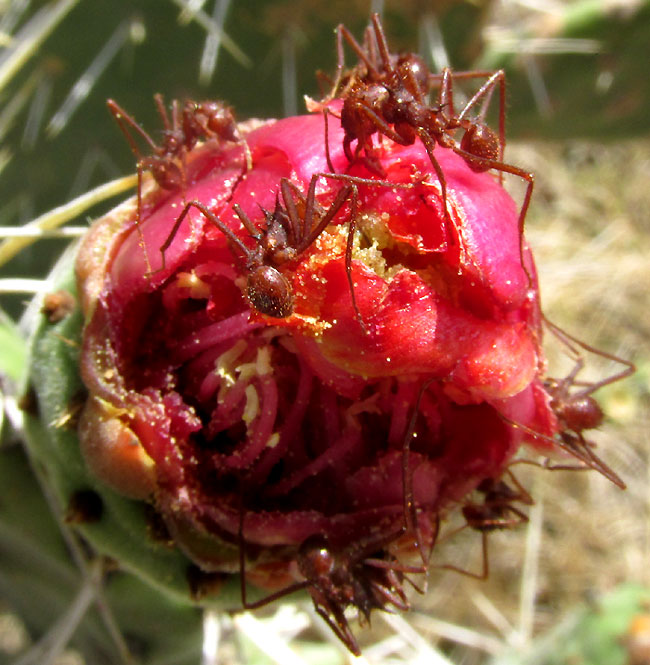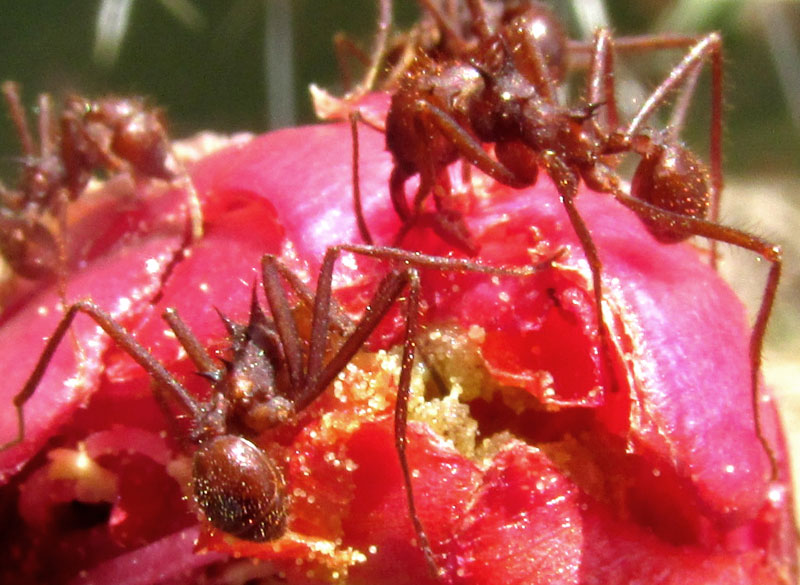Excerpts from Jim Conrad's
Naturalist Newsletter
entry dated March 31, 2023, issued from near Tequisquiapan, elevation about 1,900m (6200 ft), Querétaro state, MÉXICO
(~N20.55°, ~W99.89°)
OPUNTIA DEPRESSA

In a fencerow along a small dirt and rock road well away from town, the above pricklypear caught my eye not only because its flowers were a dark red hue I'd not seen in this area, but also, compared to other free-growing pricklypears in this area, its pads were unusually small, and for such small pads its white spines were unusually long. Up close, its flowering pads were unusually attractive:

Just for the pleasure of seeing the blossom, here's a closer look:

The ovaries were slender and thornless, or nearly so:

However, the ovary bore tufts of almost-invisible, spine-like glochids, the things that stick in one's fingers, and some of the tufts had hints of spines. Also, note that the green surfaces of the both the ovary and the pad it arises from are densely covered with short, soft, velvety hairs. Most pricklypear species aren't hairy.

Usually only two or three spines arose in each cluster. Each spine was flattened along one side, and the bigger ones twisted along their lengths. In each spine group, the lower, smaller spine often bent downward, almost paralleling the pad's surface.

The wartlike areas from which spines arose from the pads, the areoles, lacked glochids, or almost so. Finally, branches of this cactus arose from a definite trunk:

At this writing there's no comprehensive treatment of the pricklypears of our upland, central Mexican region known as the Bajío, but the priklypear genus Opuntia is covered in the 1997 Flora del Valle de Tehuacán-Chuicatlán. It deals with an especially arid area southeast of Mexico City. In that treatment our plant works out to be OPUNTIA DEPRESSA. That species' detailed descriptions and pictures on the Internet appear to confirm the identification.
The Flora describes the species as endemic just to the Mexican states of Guerrero, Morelos, Oaxaca, Puebla and Tlaxcala, an area well away from our region. However, the GBIF distribution map for Opuntia depressa shows several scattered occurrences beyond that core area, and our location fits within that expanded distribution.
However, with this cactus being my only sighting of this species in this area, and its occurring in a fencerow exactly beside a fence post, it well may have been planted, despite its obscure location mostly traveled by shepherds moving their flocks about. Also, cacti in Mexico have a long history of being transport beyond their home areas, especially ones with colorful flowers. Often it can't be said whether a plant is self-propagated, or planted.
This seems to be an exceptionally attractive species not yet discovered by the outside world. I find no gardening websites marketing it, and no studies mentioning it, other than on lists, and its description in the 1997 Flora del Valle de Tehuacán-Chuicatlán.
entry dated April 12, 2023, issued from near Tequisquiapan, elevation about 1,900m (6200 ft), Querétaro state, MÉXICO
(~N20.55°, ~W99.89°)
MEXICAN LEAFCUTTER ANTS CUTTING UP FLOWERS

Ants were busy cutting apart a flower of an Opuntia depressa pricklypear cactus. I'd read that numerous ant species feed on cactus flowers or parts of them, and I wondered which ant species this was. Once the above picture was expanded onto my computer screen and the spines on the head and thorax of the large, reddish ant were seen, it was clear it was usual ravager of leaves and occasionally other plant parts in this area, ATTA MEXICANA, often called the Mexican Leafcutter in English, though sometimes they're more loftily named the Neotropical Giant Leafcutter. Here's a closer look at the ants at work:
